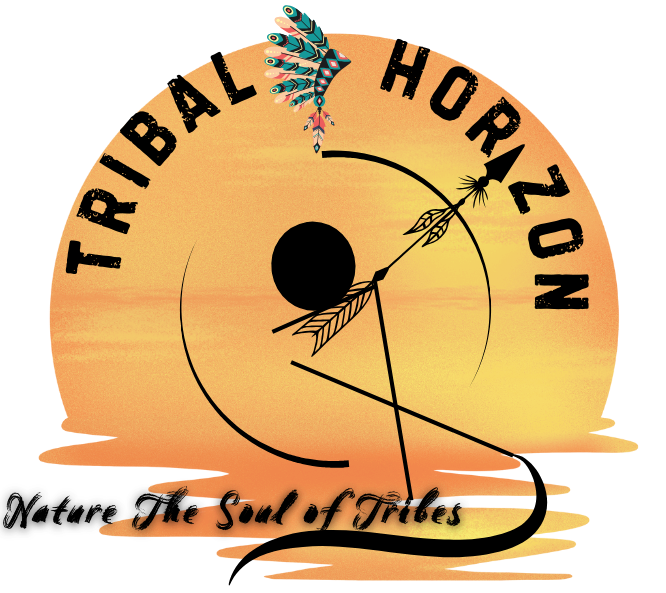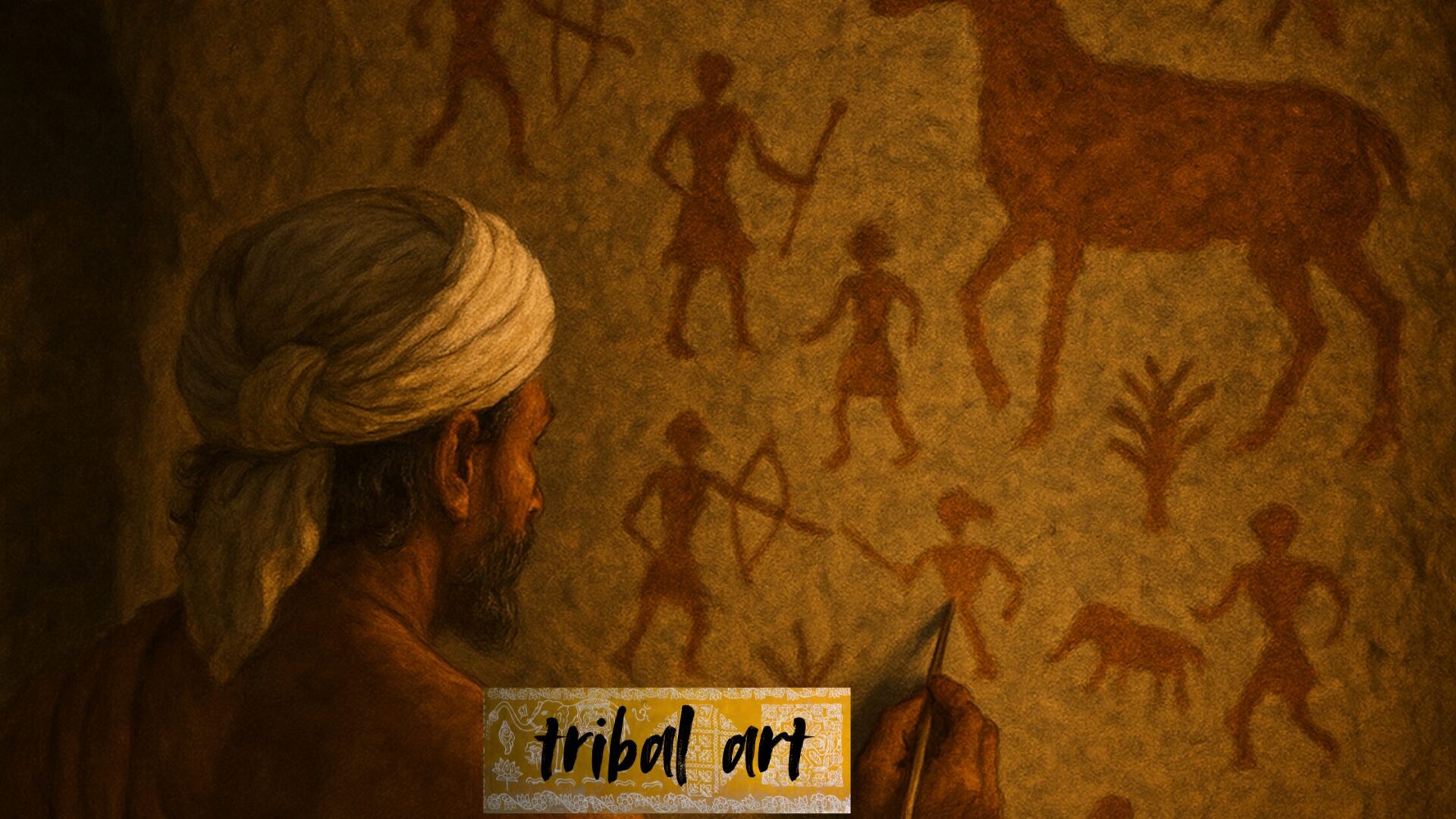Tribal art, from the ancient caves of Bhimbetka to the striking mud walls of tribal homes, exudes vibrancy and life. Today, it commands attention and admiration both in India and across the globe. This art form is deeply anchored in nature, rituals, and daily life, powerfully reflecting the essence of indigenous communities their beliefs, festivals, fears, and dreams. Each symbol and brushstroke transcends mere decoration; it embodies a rich and timeless cultural legacy.
The Origins and Evolution of Tribal Art
Tribal art is a powerful reflection of early human culture, providing profound insights into their way of life. Dating back to prehistoric times, this art form highlights the creativity and experiences of tribes that lived well before the Christian era. Early humans captured their realities on cave walls, painting scenes of hunting, rituals, and daily activities.
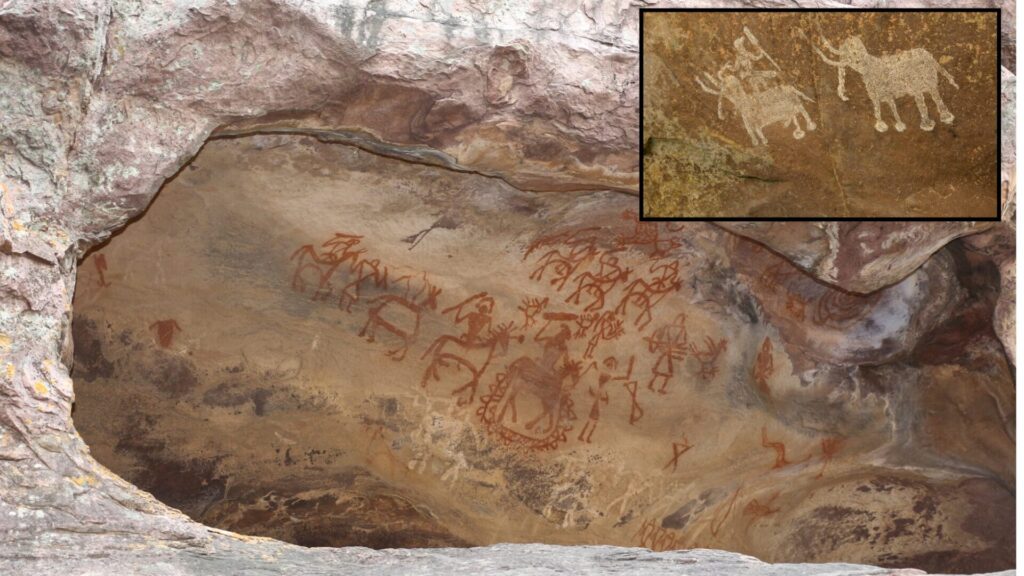
These captivating depictions are not just art; they are enduring testaments to their existence, showcasing both the mundane and the profound thoughts that shaped their lives. A prime example of this remarkable artistry can be found in the Bhimbetka rock shelters in India, where cave paintings that are approximately 30,000 years old vividly portray animals, dances, and community life.
Tribal communities across India have developed unique artistic styles over the centuries. Warli art in Maharashtra showcases geometric elegance, Gond art in Madhya Pradesh tells vivid stories, and Saura art in Odisha conveys deep spiritual symbolism. These inherited art forms have thrived through oral traditions, rituals, and a strong connection with nature, with the principles of nature deeply embedded in their expression.
Tribal art, which was initially created for spiritual, social, or religious purposes, has evolved into a powerful expression in today’s world. It commands attention in galleries and fashion, and it plays a significant role in government offices and on infrastructure like roads and bridges. In the realms of activism and digital platforms, tribal art stands as a bold symbol of heritage, identity, resistance, and the revitalisation of tribal culture.
Beyond Patterns: Unveiling the Hidden Symbols and Stunning Styles of India’s Tribal Art
Tribal art transcends decoration; it conveys powerful messages from nature. This sacred language is woven into walls, rituals, and daily life, with each Indian tribe showcasing a unique visual identity passed down through generations. The arts are deeply rooted in the land, as seen in the striking Warli figures of Maharashtra, the vibrant Gond paintings of Madhya Pradesh, and the expressive Saura murals of Odisha. These designs serve as vital blueprints from our ancestors, telling their stories without words. The art of living captures scenes that the digital age has yet to replicate.
Every line, dot, and pattern conveys important meaning about the future, linking fertility, harvest, spirits, gods, and dreams. These symbols connect the earth to the sky and compel us to see and hear with our eyes.
Let’s explore the most iconic tribal styles that still live and breathe today.
The tribal art of India is a cherished tradition passed down through generations, preserving its essence. Rooted in nature, culture, and community, each style reflects the unique worldview of its tribe. These artworks are not merely decorative; they convey meaningful stories of existence, belief, and identity, continuing to thrive in today’s world.
Warli Art: The Minimalist Magic of Maharashtra’s Tribes
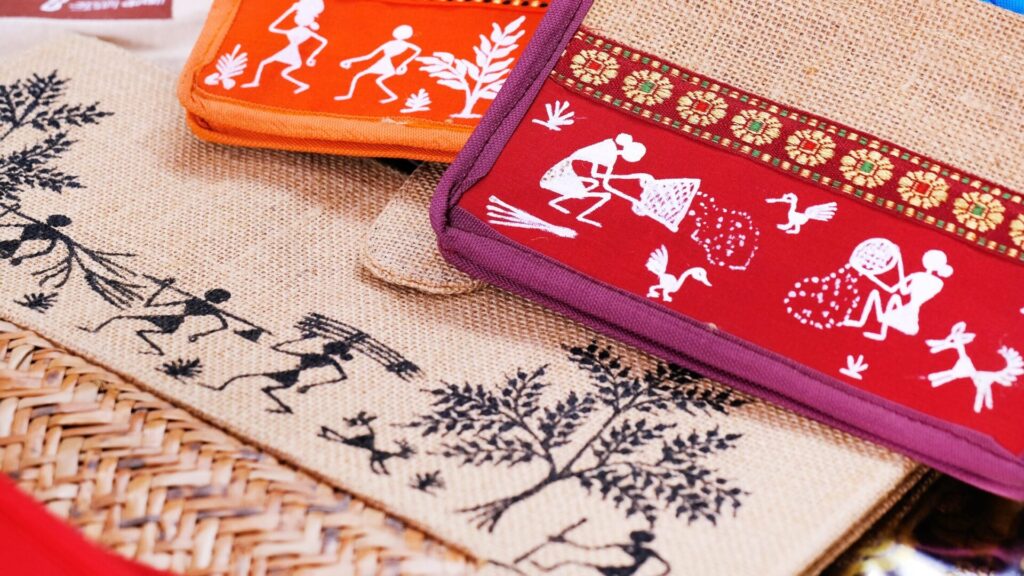
Warli art, from the Warli tribe of Maharashtra, is known for its bold simplicity and rich symbolism. Artists use white lime on mud walls to depict village life, farming, festivals, and sacred rituals. The circular “tarpa dance” and stick-like figures vividly illustrate the connection between humans and nature, embodying the essence of culture and community.
Gond Art: The Vibrant Folklore of Madhya Pradesh
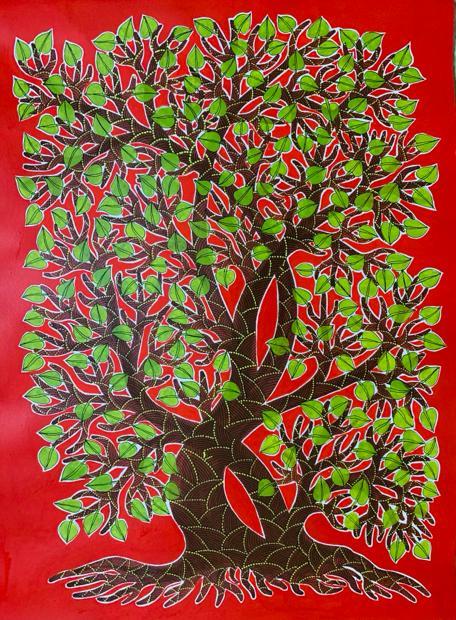
Artist: Bhajju Shyam
Many of us have seen the RRR movies featuring the little girl who weaves on an Englishwoman’s hands. Gond art, created by the Gond community of Madhya Pradesh, is a vibrant celebration of nature, mythology, and tribal legends. Through colourful dots and lines, artists bring to life animals, forests, and folklore, inspiring us to recognise the signs of nature and live in harmony with it. Each stroke tells a story, where trees breathe, deer dance, and every animal holds symbolic meaning linked to the tribe’s cultural memory.
Saura Art: The Sacred Geometry of Odisha’s Tribal Spirit
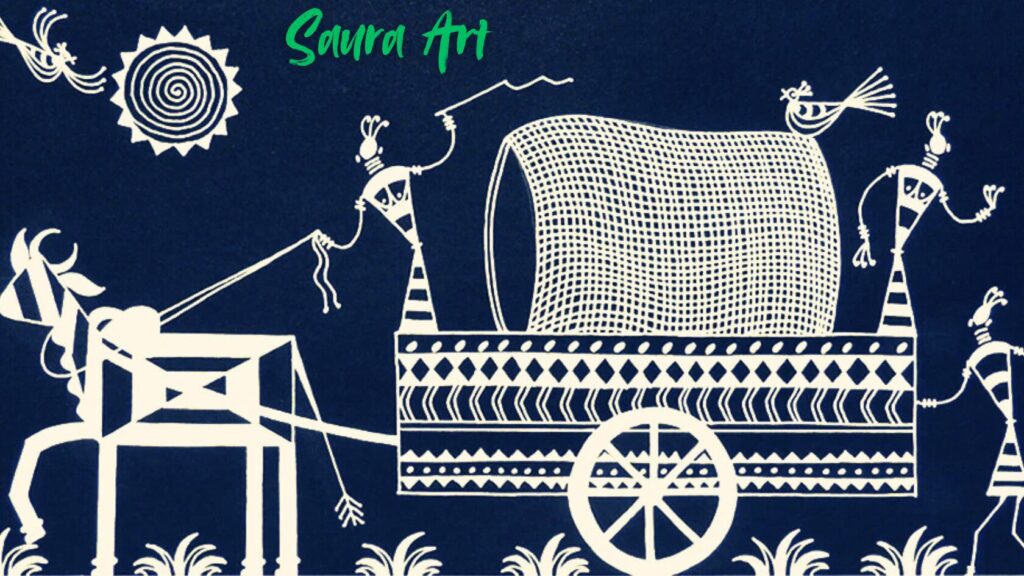
Saura art, created by the Saura tribe of Odisha, India, is a vibrant expression of spiritual symbolism and tribal identity. Traditionally painted on clay walls during festivals and rituals, these artworks feature bold geometric shapes known as “shikshas.” Often depicting ancestors, gods, and the cycle of life, these paintings serve as visual prayers that celebrate gratitude to nature and highlight the tribe’s deep connection with the natural world and the divine. Saura art is a vital part of the tribe’s heritage.
Saura paintings, rooted in the times of the Mahabharata and Ramayana, are traditionally created by the Saura tribe of Odisha using ocher. Known as “Talan” or “Chichna,” these brush-crafted artworks are dedicated to their deity, Detal, and reflect the tribe’s cultural and religious beliefs.
Bhil Art: Dots, Deities, and Daily Life from Rajasthan and MP
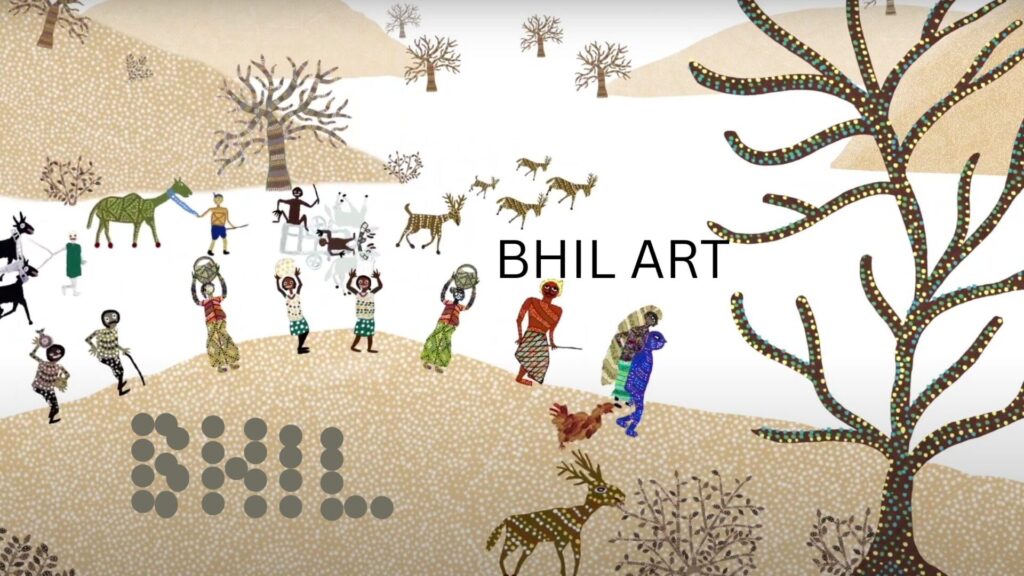
Bhil art, created by one of India’s largest tribal communities, is a vibrant expression of culture, characterised by rhythmic dots, earthy colours, and powerful symbolic patterns. Bhil artists skilfully use neem branches as brushes and natural pigments to portray gods, festivals, crops, animals, and ancestral memories. Each piece of art not only reflects everyday life but also intertwines with mythology, creating a dynamic world that is both ancient and alive with energy. This art is a vital testament to the history of the tribes, showcasing the legacy of these original inhabitants. Understanding their paintings is essential to appreciating the profound connection they have with nature.
Forgotten Brushes, Rising Voices: The Struggle and Revival of Tribal Artists
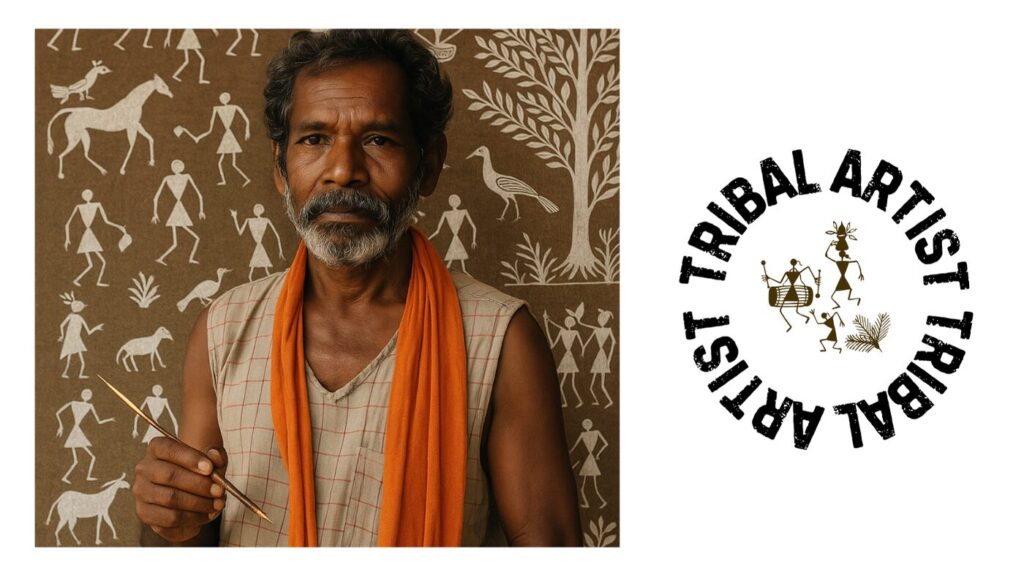
For generations, tribal artists have painted on mud walls and in caves to express their beliefs, rituals, and connection with nature. These artworks convey powerful stories and lessons from ancestors that still resonate today. While their simple brushes served as extensions of their identity, the rise of cities and modernisation has sidelined these voices. However, today’s tribal youth are determined to revitalise their cultural identity and preserve this invaluable art form for future generations.
Tribal art forms are at risk of extinction as younger generations pursue urban jobs and neglect traditional crafts. They’ve recognised that middlemen exploit artists, offering them meagre compensation for their work. While museums preserve their art, they often fail to acknowledge the creators. The world celebrates their artistry but ignores the artists themselves, and it’s time to change that.
But the story does not end in silence.
In recent years, tribal art has experienced a powerful revival, led by passionate artists, activists, and cultural movements. Community workshops and national art fairs are helping tribal creators reclaim their voices. Today’s youth proudly adorn their homes with tribal art, celebrating their cultural identity at weddings.
Support from NGOs and government initiatives is providing artists with training and income opportunities. With the rise of digital platforms and social media, tribal artists are gaining exposure and successfully collaborating with fashion brands, interior designers, and modern galleries, showcasing their artwork in innovative ways. This resurgence highlights the resilience and creativity of tribal art and its creators.
Today, these “forgotten brushes” are no longer silent. They speak boldly, painting not just walls but hearts around the world.
Why Tribal Art Still Speaks to the Modern World
In the era of modernity, amidst the digital noise and fleeting trends, tribal art stands as a timeless and sacred expression. It is rooted in authentic experiences and commands attention with a unique allure that transcends mere aesthetics. Its powerful whisper resonates deeply, touching hearts across continents.
Why?
Because tribal art embodies more than just shapes and colours, it conveys rich stories, profound emotions, and the very essence of humanity. It strikes at the core of our connection to nature, making its impact undeniable.
Modern individuals, navigating through a landscape of glass skyscrapers and concrete, often feel a yearning for something authentic from nature. They find this connection in tribal art, which embodies simplicity, balance, and significance. Each symbol conveys a message of unity, respect for nature, harmony with life, and the importance of tradition. The contemporary world is gradually rediscovering these values, and art is reflecting this renewed perspective on life.
Designers take bold inspiration from it, and fashion confidently adopts its captivating trends. Warli art transforms walls in homes, and esteemed global museums acknowledge its profound impact. Today, tribal art commands attention in various spaces from government offices to schools and private workplaces, radiating positivity and wonder. More than just a visual delight, tribal art makes a powerful statement: true beauty doesn’t seek fame, and authentic expression needs no validation. Its raw, emotional essence is undeniably human, ensuring it resonates powerfully in our lives today.
Celebrate with Heart, Support with Action: A Guide to Saving Tribal Art
Appreciating and honouring tribal art is only the first step. Preserving it requires dedication and effort. These living traditions, rooted in forests, festivals, and faith, have endured for centuries. However, they are now at risk of extinction, not due to nature, but because of changing mindsets among people.
Good Things Are Happening. Want to Make Them Great
Start by making your purchases directly from tribal artists at tribal conventions, local haats, cultural fairs, or on online platforms like TRIFED, Adi Mahotsav, and artist-run Instagram and YouTube pages. Always give them the credit they deserve. Artists thrive on appreciation for their work, and every purchase underscores the message, “Your art truly matters.”
Engage with exhibitions, workshops, or online sessions, and participate not just as buyers but as attentive listeners. Inquire about the creativity and journeys of tribal artists to truly understand their perspectives. Tribal artists are more than just sellers; they are vital voices for their culture. Support NGOs and community-driven initiatives that empower tribal children to wield a paintbrush and carry forward the artistic legacy of their ancestors. Your contributions, whether a small donation or a simple share on social media, can make a significant impact.
If you have the means, consider organising an event that showcases tribal artists and educates others about their exceptional art, fostering a deeper appreciation for their work. Incorporate tribal art into your spaces homes, offices, and schools. Use tribal designs in your invitation cards and give them the prominence they deserve.
Highlight tribal art in your projects, feature it on social media, and discuss it in conversations. Champion this heritage; give it the respect it commands. Tribal art demands pride and dignity, not sympathy. When you support a tribal artist, you’re not merely buying a painting; you’re reviving a rich heritage, preserving a dialect, and ensuring a culture thrives. You’re breathing life into cherished traditions and making a meaningful contribution to the environment.
Tribal Art Speaks If Only We Choose to Listen
Tribal art does not shout for attention or demand prominence; it exists with quiet dignity. Carved in ochre, painted with white rice paste, brushed onto ochre-textured clay walls, and applied to bamboo, bark canvases, and beaten metal, it commands a presence that speaks volumes. It consistently communicates and makes a powerful connection with nature. The question is: are we truly listening?
Every line, dot, symbol, and trace reveals the reality of existence. It reflects not only art but also the lives of people, their roots, and their relationship with nature. This is a life lived in harmony with forests, animals, ancestors, and the divine. There are no filters or fabrications, just the truth and reality as dictated by nature itself.
These discussions are not fading away due to a loss of significance or a lack of attention. Instead, we see natural forests being replaced by concrete structures, and fast art taking over from slow rituals. In this loud world, the voices of communities are assertively drowning out the silence that once characterised the concrete landscape.
till time. Still hope. Still you
Taking the time to pause and appreciate this art helps us protect a living spoken language and teaches the next generation that culture is important. True beauty lies not just in trends but also in the deeper truths that shape our reality. By valuing these expressions, we enrich our cultural landscape.
Because tribal art does not die. It has been alive for 3000 years. It is waiting. Waiting for someone, perhaps you.
A Legacy in Every Line: Don’t Let the Stories of Tribal Art Fade Into Dust
They painted with clay on sun-kissed walls, creating art filled with love, memory, and rituals, no galleries or spotlights needed. These unnamed artists—mothers, farmers, elders, and storytellers expressed themselves through vibrant lines that conveyed births and beliefs. This is the essence of tribal spirituality, capturing life as a natural camera does.
If tribal art disappears, it won’t just be the loss of colors on a wall.
We will lose our folk songs, ancient stories, forest wisdom, and symbols that connect us to our roots.
This is not just art.
It is a legacy, a tradition passed down for generations.
It is a voice preserved in silence.
Let us not be the generation that turns away.
Look again.
Feel again.
Share again.
Because once these stories are gone…
Some may never return.
FAQ
What is tribal art?
Tribal art is a traditional form of expression practised by indigenous communities. It encompasses paintings, murals, carvings, tattoos, and crafts that are deeply connected to their nature-based lifestyles, rituals, festivals, and spiritual beliefs.
How can I support tribal artists?
Buy original art , Attend tribal art fairs , Follow tribal art pages, Promote on social media, Donate to indigenous art NGOs.
Is tribal art still practised today?
Absolutely! Although some forms are diminishing, many artists and communities are actively reviving and preserving these ancient traditions. With the right support, tribal art is reclaiming its voice.
Is tribal art only decorative?
Tribal art is beautiful but serves spiritual, cultural, and narrative purposes, with each element representing rituals, deities, daily life, and dreams.
Conclusion
Tribal art is far more than mere lines on clay walls or dots on canvas; it represents a vibrant essence that thrives in remote villages, resonating with ancient songs in contemporary settings. It profoundly reveals our history and offers powerful insights into our potential futures. To understand tribal art is to grasp not only who we were but also who we are destined to become. This is a journey of exploration that holds immense significance.
But it needs us now, not just as admirers, but as protectors. To encourage it.
Every purchase, share, and story helps keep this ancient voice alive. You honor the generations who created for faith and passion. Let’s not just observe tribal art; let’s listen to it, learn from it, and respect it. When we preserve their stories, we preserve a part of ourselves.
Your feedback means a lot to us.
If you have any questions, suggestions, or concerns feel free to leave a comment below. We’re here to listen, grow, and improve together.
Thank you for being a part of this journey.
